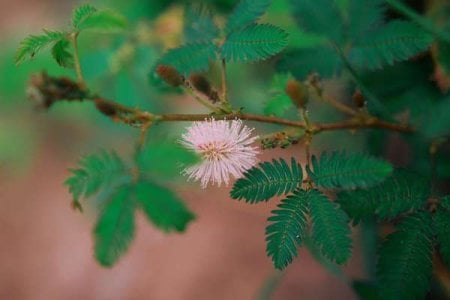Beware the Allure: The Shocking Danger Lurking in This Australian Woman's 'Cool' Backyard Plant
By
Danielle F.
- Replies 0
In the world of gardening, not all that glitters is gold, and sometimes the most enchanting plants can hide a sinister secret. This was the case for one Queensland woman who discovered a 'very cool looking' plant sprouting amidst her lawn in Moreton Bay. With delicate leaves and soft pink flowers, the plant's beauty was undeniable, but its true nature was far from benign.
The woman, intrigued by the mysterious plant, took to social media to seek identification from the local green thumbs. She noted its peculiar behaviour: 'It closes its leaves when touched.' The plant, which captured her curiosity, is known as mimosa pudica, also referred to as the sensitive plant or touch-me-not. While its shy, leaf-folding reaction to touch may seem charming, experts warn that this plant is an invasive weed with potentially harmful effects.
Dr Carol Booth, a principal policy analyst at the Invasive Species Council, shed light on the plant's troublesome characteristics. The mimosa pudica, recognised for its leaves that fold inward when disturbed and during nighttime, is an unwelcome guest likely introduced as an ornamental garden plant. It has become a significant problem in coastal regions of Australia, particularly in the north and Central Queensland, with sightings in New South Wales and near Darwin.
Although not yet declared a weed of national significance, the Northern Territory and Western Australia have classified it as a pest. Its spread is facilitated by the movement of people and animals, as well as through seeds mixed in gravel. Dr Booth emphasised the plant's adverse impact on both agriculture and conservation. 'It typically thrives in disturbed areas and can form a dense ground cover that displaces other plants,' she explained. The mimosa pudica also alters soil properties and microbial communities, paving the way for further invasive species.
The plant's presence is not just an ecological concern; it poses a direct threat to livestock. Dr Booth mentioned that the sensitive plant was among the many legume species introduced to Australia as potential cattle pasture, despite its probable toxicity to cattle. The Centre for Invasive Species Solutions corroborates this, noting that the plant is suspected of causing cattle poisoning. While it may sometimes cause skin irritations, it is not believed to be harmful to humans or pets.
To combat the spread of this invasive weed, Queensland residents are urged by the government to take reasonable measures to control such plants on their properties, with herbicide being the most common method. Gardeners who have encountered the plant shared their advice online, emphasising the importance of removing it carefully. 'Don't mow over it, or you will have it everywhere. Pull it out by the roots and wear gloves,' one person advised. Another gardener shared their battle with the plant: 'I have to regularly monitor our acre property for clumps of it! Then it's out with heavy-duty gloves and a long screwdriver to dig it out. We hate it with a passion!'
The story of the mimosa pudica serves as a cautionary tale for Australian gardeners. Its allure may be tempting, but the risks it poses to the environment and agriculture are too great to ignore. If you come across this plant or any other suspicious growth in your garden, it's best to consult with local environmental authorities or a knowledgeable gardener before taking action.

So, dear readers of the Seniors Discount Club, let this be a reminder to stay vigilant in your gardens. The next time you spot an unfamiliar plant, take a moment to investigate before you let it take root. Have you encountered any invasive plants in your own backyard? Share your experiences and tips in the comments below – your insights could help a fellow gardener in need!
The woman, intrigued by the mysterious plant, took to social media to seek identification from the local green thumbs. She noted its peculiar behaviour: 'It closes its leaves when touched.' The plant, which captured her curiosity, is known as mimosa pudica, also referred to as the sensitive plant or touch-me-not. While its shy, leaf-folding reaction to touch may seem charming, experts warn that this plant is an invasive weed with potentially harmful effects.
Dr Carol Booth, a principal policy analyst at the Invasive Species Council, shed light on the plant's troublesome characteristics. The mimosa pudica, recognised for its leaves that fold inward when disturbed and during nighttime, is an unwelcome guest likely introduced as an ornamental garden plant. It has become a significant problem in coastal regions of Australia, particularly in the north and Central Queensland, with sightings in New South Wales and near Darwin.
Although not yet declared a weed of national significance, the Northern Territory and Western Australia have classified it as a pest. Its spread is facilitated by the movement of people and animals, as well as through seeds mixed in gravel. Dr Booth emphasised the plant's adverse impact on both agriculture and conservation. 'It typically thrives in disturbed areas and can form a dense ground cover that displaces other plants,' she explained. The mimosa pudica also alters soil properties and microbial communities, paving the way for further invasive species.
The plant's presence is not just an ecological concern; it poses a direct threat to livestock. Dr Booth mentioned that the sensitive plant was among the many legume species introduced to Australia as potential cattle pasture, despite its probable toxicity to cattle. The Centre for Invasive Species Solutions corroborates this, noting that the plant is suspected of causing cattle poisoning. While it may sometimes cause skin irritations, it is not believed to be harmful to humans or pets.
To combat the spread of this invasive weed, Queensland residents are urged by the government to take reasonable measures to control such plants on their properties, with herbicide being the most common method. Gardeners who have encountered the plant shared their advice online, emphasising the importance of removing it carefully. 'Don't mow over it, or you will have it everywhere. Pull it out by the roots and wear gloves,' one person advised. Another gardener shared their battle with the plant: 'I have to regularly monitor our acre property for clumps of it! Then it's out with heavy-duty gloves and a long screwdriver to dig it out. We hate it with a passion!'
The story of the mimosa pudica serves as a cautionary tale for Australian gardeners. Its allure may be tempting, but the risks it poses to the environment and agriculture are too great to ignore. If you come across this plant or any other suspicious growth in your garden, it's best to consult with local environmental authorities or a knowledgeable gardener before taking action.
Key Takeaways
- An Australian woman discovered a 'very cool looking' plant with pink flowers in her lawn, which turned out to be an invasive weed called mimosa pudica.
- Commonly found in coastal Australia, mimosa pudica is a pest that can disrupt local ecosystems by altering soil properties and outcompeting native plants.
- The weed is potentially toxic to cattle and can cause skin irritations, requiring Queensland residents to control it on their properties to prevent further spread.
- Gardeners advise against mowing over the plant and recommend wearing gloves and using tools to remove it by the roots to avoid proliferation and possible skin irritation.








